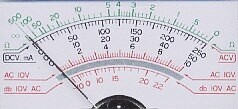|
Anyone who has read through these pages will realize that the older analogue meters have a place in this heart. There are a lot of good reasons for having them and below is just a few of them.
As dB is a relationship between two signals we'll first need to establish a reference point to which we can reference our dB scale. A handy reference is dBm which is the signal level in dB relative to 1mW. 0dBm is simply when the injected voltage causes a load to dissipate 1mW. But this still does not give us a voltage, multimeters cannot measure power. I'm not quite sure of the history of 600Ω (apart from the fact it relates to a very handy conductor diameter/spacing ratio) but the dB scale revolves around this 'magical' impedance. If we mix the reference of 0dBm and 600Ω we would land up with a voltage that would cause 1mW to dissipate, this being 0.775V. This reference was first known as 0dBm@600Ω, but as time went on it became shortened to 0dB, especially as all telephony and audio networks were working at 600Ω. In fact, not only was 0dB the reference, it also became known as 0VU (Volume Units). This handy scale, although directly linked to dB, removes the reference to dBm (and thereby any reference to impedance) and bases the scale purely on voltage with 0VU equal to 0.775V. This new scale, as it was no longer based on power, needed a new designation and became known as dBu. As this scale is based purely on voltage, and a multimeter can read voltage, the dB scale on a multimeter is centered on this voltage referenced scale. Please note: when we talk of VU we are talking true VU, not as an indication on a piece of equipment when running at optimum signal, for example a tape recorder. But 0dBu, 0.775V, is not an easy reference to remember, but 2dB = 1V is (actually, it's 2.22dB but that's close enough). But now comes the next problem when changing scales on the meter. It would be handy if when changing scales all that was required was a simple addition to arrive at the signal level. This is where the scales of 1, 3, 10, 30, 100, etc. are used. 20log(3/1)=9.5dB, and 20log(10/3)=10.5dB. This means for every click on the meter one adds approximately 10dB. There is an error of ±0.5dB but it's close enough to suffice while keeping the number of switch positions (and also the costs) to a minimum. The more modern meters, with ranges 1, 2, 5, 10, etc., are more accurate but require additions of 6, 8, and 6dB (more accuracy, but more complexity). So, the next time you think of throwing out the old analogue meter for a digital one, just cast a thought to how intelligent the analogue one was. It makes one wonder if digital multimeters are replacing analogue ones because modern engineers are not taught the basics?
© 04.08.01 |
 Ever wondered what the dB scale was on a analogue multimeter (usually the lowest scale on the face)? If you are involved in audio or telephony work you'll have worked with dB, but how is this related to a scale on a multimeter?
Ever wondered what the dB scale was on a analogue multimeter (usually the lowest scale on the face)? If you are involved in audio or telephony work you'll have worked with dB, but how is this related to a scale on a multimeter?